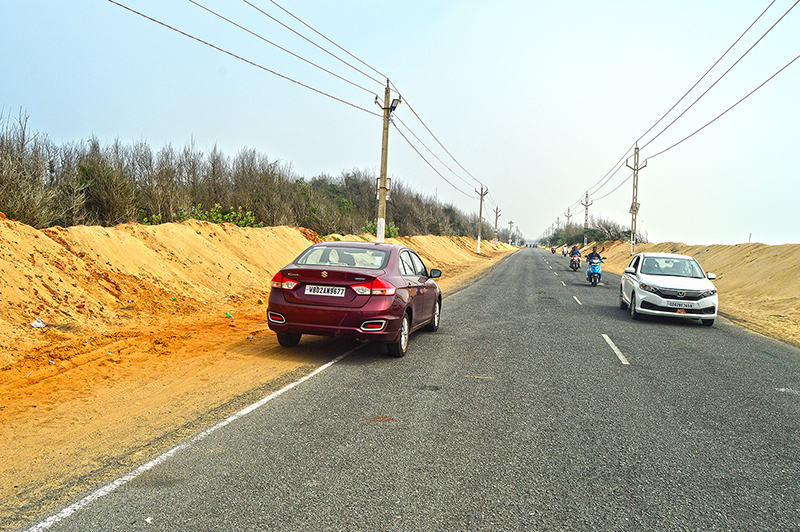
Team WHEELS on Puri-Konark Marine Drive
Waking up to the sound of the waves of the deep blue hitting the beach at the crack of dawn, we stretched luxuriously. Another day for Team WHEELS to sink into its warm embrace. Another day, yet again, where we could let our hair down and enjoy untrammeled freedom as we explored the vignettes of this resplendent beach city – Puri.
A hearty breakfast at the East West Hotels provided us with just that right amount of zeal needed to pursue on our trail of Odisha architecture – the renowned Sun Temple at Konark.
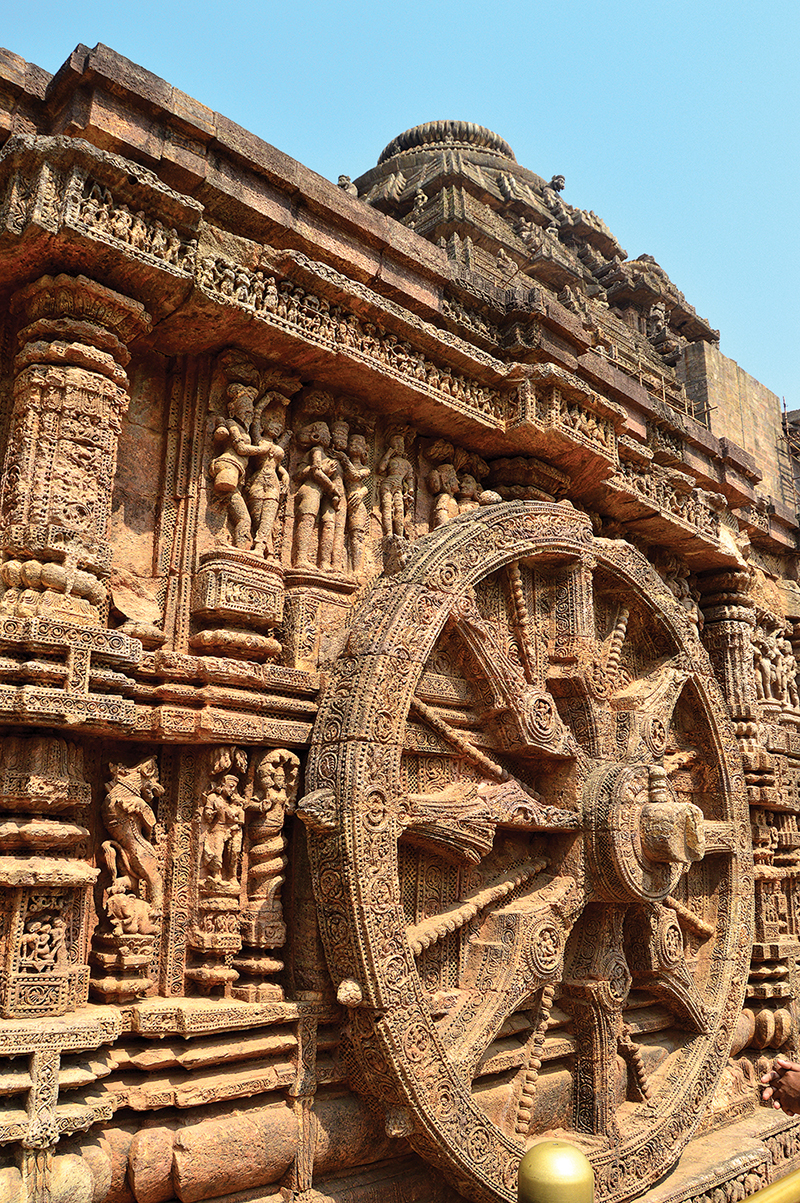
Chariot wheels of the main shrine work as sundials
ROUTE
Start from Vidyasagar Setu and enter NH-16 (NH-6) following the slip-road on the left at the end of Kona Expressway. Continue straight on NH-16 (NH-6) towards Kolaghat. Follow the underpass before Kharagpur, turning left to continue on NH-16 passing through Belda, Jaleswar, Balasore and Bhadrak. Go over Mahanadi Bridge, followed by Cuttack and proceed towards Bhuvaneswar. Just after crossing the second bridge on River Mahanadi before Bhuvaneswar, enter the service lane on the left, indicating ‘Puri’, leaving NH-16. Continue for 200 meters till you reach a four-point crossing. From here, turn left to enter NH-316 and proceed towards Puri.
After 56 km from Bhubaneswar, you will find a road on your left that connects Konark, followed by a flyover across NH-316. Within 1.5 km of the flyover (with an Indian Oil pump on left), there is a Y-fork. The left of the Y-fork is the conventional route to old Puri passing through narrow and congested roads.
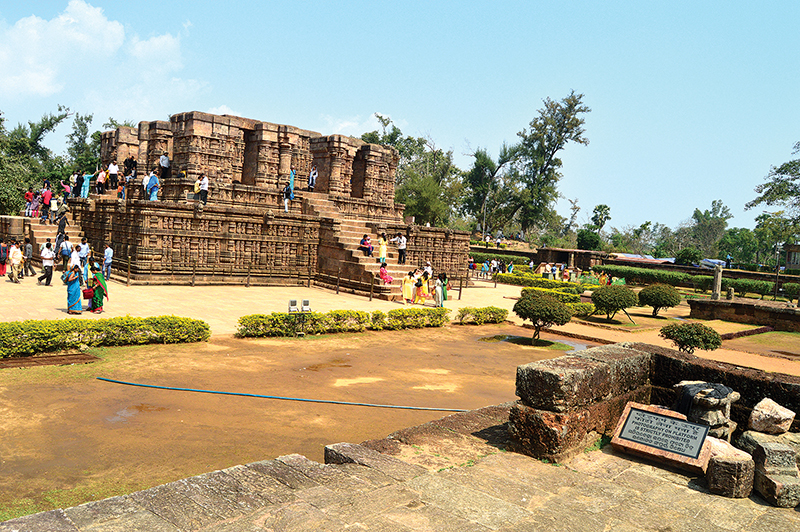
Elevated entrance of the temple
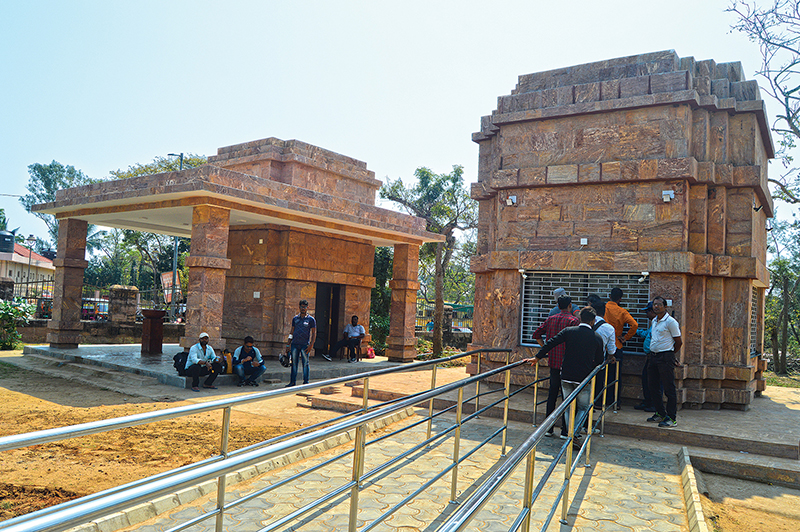
A themed ticket counter
WHEELS recommends you take a right from the Y-fork that passes through Satapada and connects the western end of Puri through the newly constructed Jagannath Sadak. The road would take you directly to the west end of Puri’s Marine Drive through Baliapanda, meeting the sea. A left turn on Marine Drive would connect you to Swargadwar.
For driving to Konark from Puri, take the new Jagannath Sadak and proceed towards Bhuvaneswar. In 15 km, make a U-turn on NH-316 for the flyover towards Konark. Follow the flyover to hit a T-junction on the Puri-Konark Marine Drive (where the road from old Puri meets from right). Turn left from the T-junction and follow the Puri-Konark Marine Drive for another 27 km to reach Konark.
At the end of the road is the Chandrabhaga Beach. Turn left from the beach to find the Sun Temple car parking. Team WHEELS recommends (although the old route from Puri is shorter by 12 km), the new route as faster and better.
The road from Puri to Konark is very picturesque, dotted with sand dunes and Casuarina trees. However, due to the tragic effects of Cyclone Fani, hundreds of Casuarinas that once lined the roads, now lie uprooted, by the side of the road. Enroute, there was a light drizzle that was replaced by glittering sunshine before we reached the temple. The drive took us a little more than an hour.
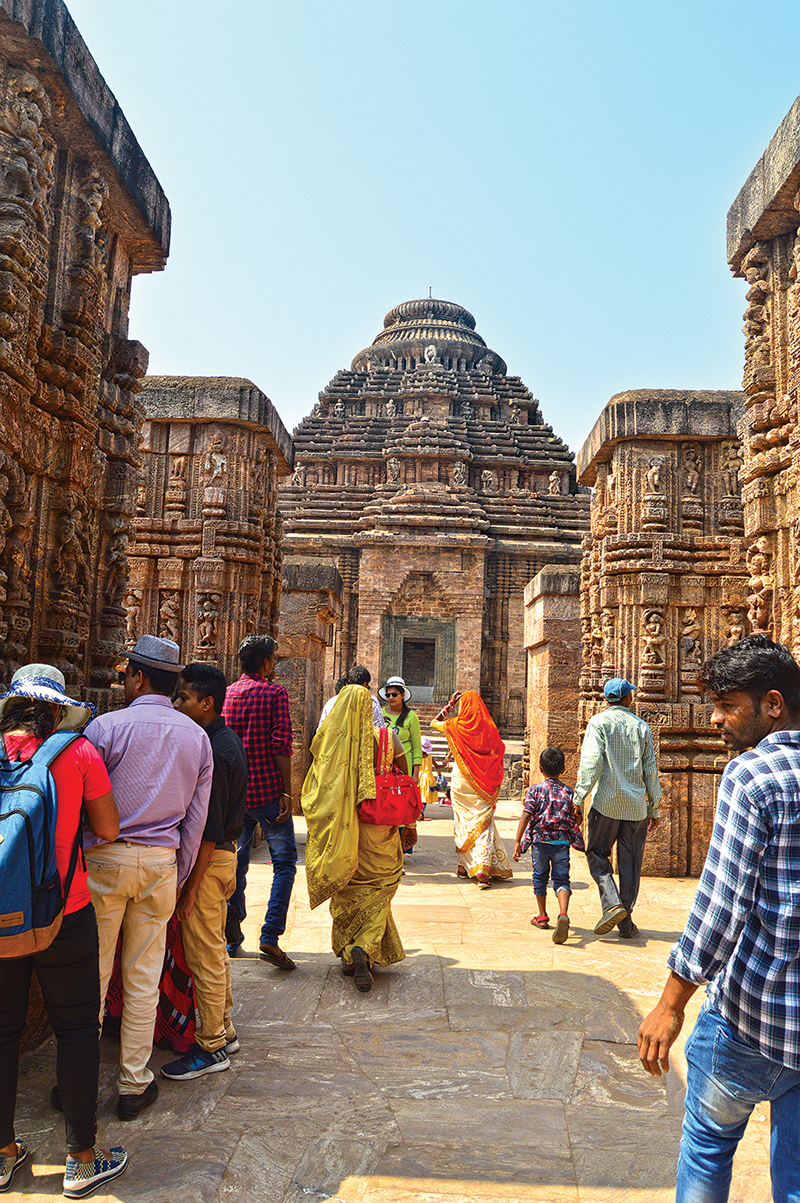
Approach to the temple
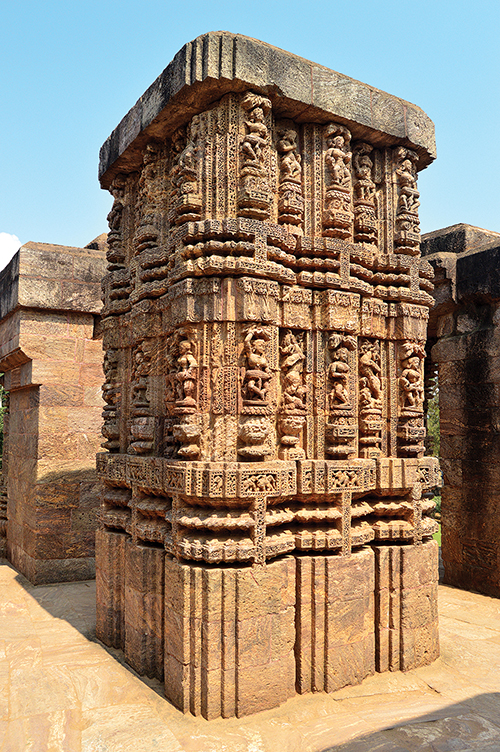
Dancers carved out of laterite stone
KONARK
There are three entrances to the Sun Temple. In the absence of a dedicated parking lot for private cars, we had to park our car on the road near the temple complex earmarked for parking and walked down to the temple.
The multitude of souvenir shops selling traditional gift items inside the temple complex were (qualifying multitude) was a major distraction. Having purchased our entry tickets, we made our way to the temple. Treading the compound in the scorching sun, without our umbrellas and drinking water, would have been difficult as there is hardly any shade to be found anywhere inside the complex.
HISTORY
Standing stark and proud amidst the surrounding sands, the Sun Temple at Konark, a UNESCO World Heritage Site, is the perfect example of an era when Kalingan architecture had reached its pinnacle. We marveled at the majestic temple of the 13th century with the geometric precision of its intricate carvings. It is believed to have been built on the edge of the sea–which today has fortunately receded to a respectful distance.
Built in the 13thcentury by King Narasimhadeva of the Ganga dynasty, the magnificent temple resembles the mythological chariot of Suryadev (the Sun God) with twelve wheels on either side and pulled by seven horses. We realized that from the sides, the temple looks exactly like a chariot, and from the front, a temple. The seven horses of the chariot-temple are believed to represent the days of a week, while the wheels of the temple are sundials, depicting a 12-hour cycle that can be used to calculate the time accurately to the minute. A guide showed us how to calculate the time with the help of the sunlight falling on the wheels.
Though the main tower no longer exists, we discovered that the architecture resembles the holy JagannathTemple of Puri. On either side of the main temple are colossal figures of royal elephants and horses. Of the 22 subsidiary temples that once stood within the enclosure, the two that remain are the Vaishnava and Mayadevi Temple.
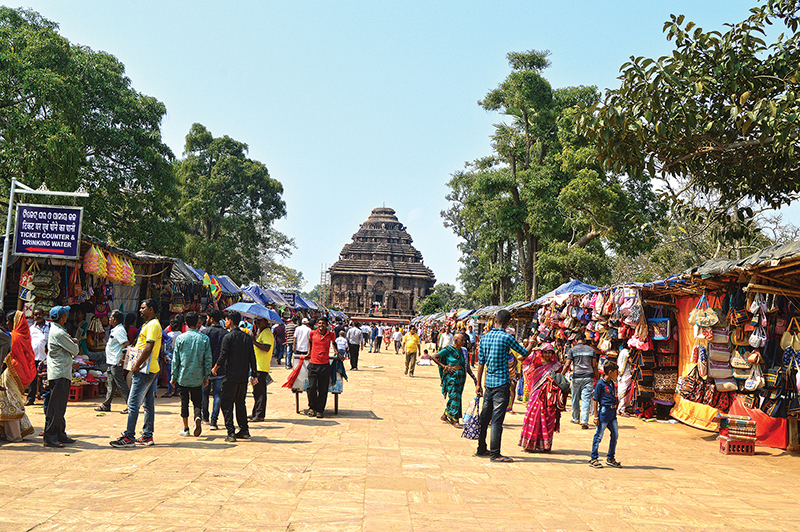
Souvenir shops on temple precincts
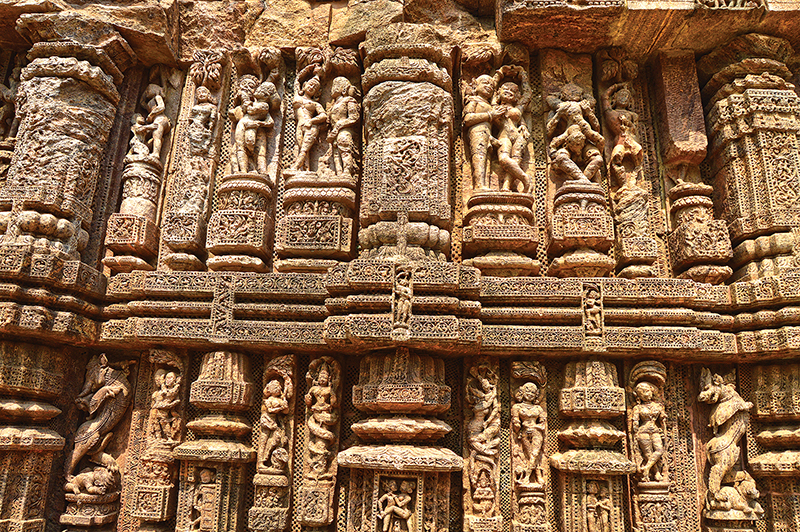
The 700-year old sculptures are mostly intact
STRUCTURE
The original temple, which had a main sanctum sanctorum (vimana), estimated to have been 229 feet tall, is supposed to have collapsed in 1837. The main mandapa or hall (Jagamohana), which is about 128 feet tall, still stands and is the principal structure in the surviving ruins. Among the structures that have survived to the current day are the dance hall (natamandira) and the dining hall (bhogamandapa).
SCULPTURE
The social life of the 13th century commoners, as well as the royals, can be seen in the cleverly carved stone images of hunts, lovers, deities, dancers, birds, animals and mythological creatures. Girls are seen wringing their wet hair, standing by a tree, playing with pets, preening before a mirror.
The Konark temple is also known for its erotic sculptures of mithunas. These depict couples in various stages of courtship and intimacy. The sculptures on the temple's Shikhara illustrate the bandhas (mudra forms) described in the Kamasutra.
The upper levels and terrace of the Konark Sun Temple contain larger and more significant works of art than the lower level. These include images of musicians and mythological narratives as well as sculptures of Hindu deities, including Durga in her Mahishasuramardini avatar, killing the shape-shifting buffalo demon (Shaktism), Vishnu in his Jagannatha form (Vaishnavism), and Shiva as a (largely damaged) linga (Shaivism).
The cause of the destruction of the Konark temple is unclear and remains a source of controversy. While some theories talk about natural damage, others speak of deliberate destruction in the course of being ransacked several times by Muslim armies between the 15th and 17th centuries.
During the British rule, steps were taken for the conservation of the remaining part of the temple. To save the jagmohan from possible collapse, the four entrances were permanently closed, and the interior was filled with sand, vertically from the top, by drilling a hole and pouring sand through a funnel. The conservation of the Konark Temple was taken over by the Archaeological Survey of India (ASI) in 1939. We spent a couple of hours admiring the magnificent 700 year old sculptures and clicking endless photographs.
THE INTERPRETATION CENTRE
Coming out of the temple, we visited the Interpretation Centre opposite the exit gate. The Centre, with its collection of sculpture-replicas from the Sun Temple ruins, contains rare documents and fascinating theories regarding the temple architecture, structure, and sculpture, as well as its history endorsed by ASI.
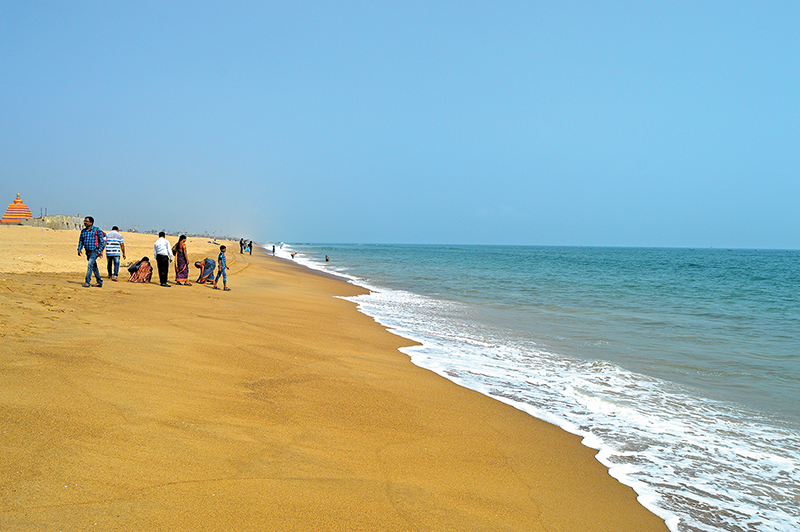
Golden sands of Chandrabhaga Beach – a major attraction of Konark
CHANDRABHAGA BEACH
Just before the Sun Temple in Konark is the serene Chandrabhaga beach named after the river –almost dried up now. Legend has it that Lord Krishna’s son Shambo prayed here to the Sun God and was cured of his leprosy.
After parking at the huge lot, we walked down to the beach. Thanks to the weather, which had once again turned cloudy by then. Shops selling gift items and food stalls packed with sea-food items were tempting. But there was something more fascinating– the variety of water-sport options ranging from water scooter, snorkeling, surfing, sailing to boating.
For nature lovers, there are luxury tents set up on the sand bar near Ramchandi, close to the Chandrabhaga Beach. We were super excited at the sight of the tents and promised to be back soon.
After returning to the East West Hotel, we enjoyed a traditional lunch and retired to our rooms for a siesta.
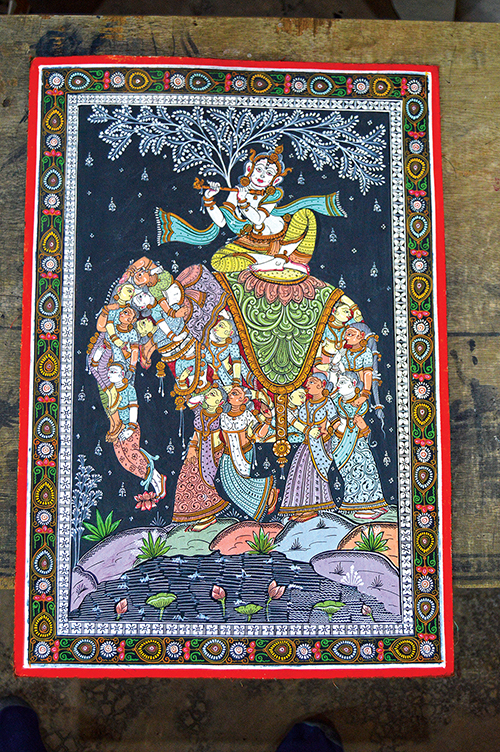
A fine work of patachitra
RAGHURAJPUR CRAFTS VILLAGE
In the late afternoon, Team WHEELS drove down to yet another interesting destination, Raghurajpur, a heritage crafts village, close to Puri.
Route: For Raghurajpur, follow the new Jagannath Sadak and go over to the other side of NH-316 near Chandanpur Bazaar.
The entry to Raghurajpur is through a small village called Nayakpatana. The craftsmen at the entry to the Nayakpatana village ushered us into their homes, which we found filled with the unique local handicrafts. We were certain that we had arrived at Raghurajpur. But after interrogation, the villagers confessed that Raghurajpur was a few hundred metres away. Thus a word of caution: Do not confuse Nayakpatana with Raghurajpur crafts village.
HANDICRAFTS
Situated amidst groves of coconut, palm, mango and jackfruit trees, Raghurajpur is a heritage crafts village. Best known for its Patachitra painters – an art form that dates back to 5 BC and Gotipua dance troupes, Raghurajpur is the precursor to the Indian classical dance form of Odissi.
Raghurajpur is a unique, quaint village. A series of twelve temples dedicated to Bhuasuni, the local deity, and also various other Hindu gods such as Radha Mohan, Gopinath, Raghunath, Laxminarayan and Gouranga occupy the central flank, while two lanes on either side of the temples lead to the houses of the artisans lined up one beside the other.
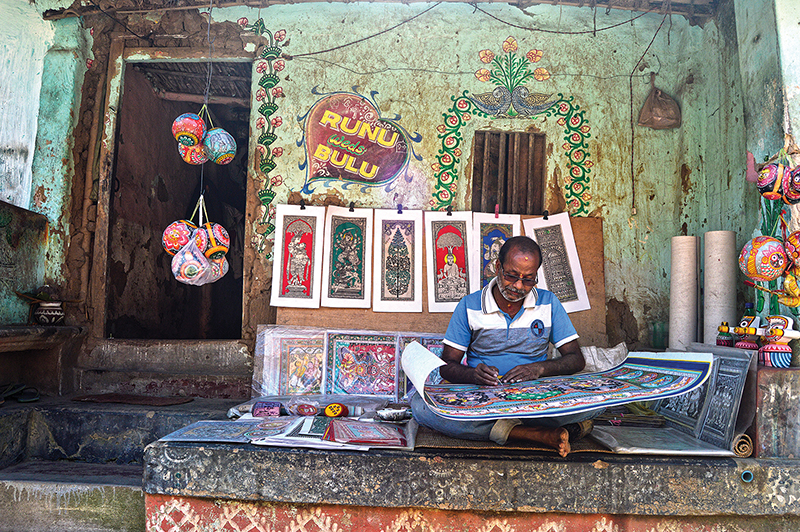
Indigenous paintings on different media
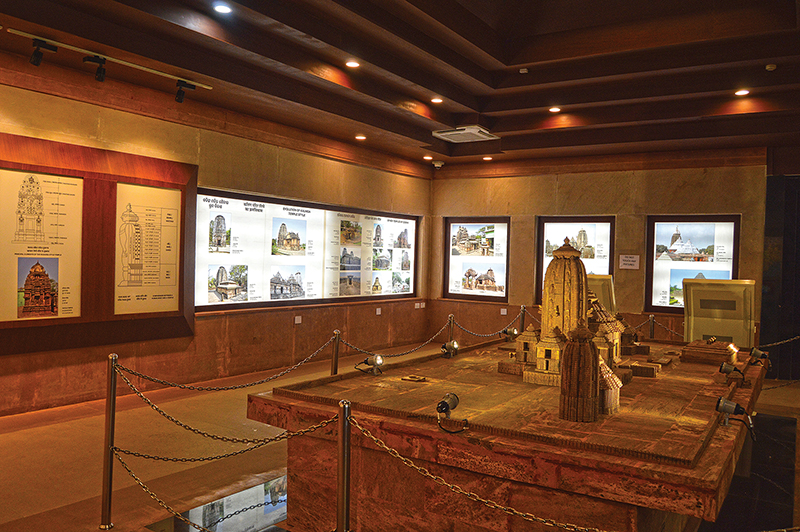
Interpretation Centre – decoding the Sun Temple
Raghurajpur is home to crafts like patachitra, Tussar paintings, palm leaf engravings, stone and wood carvings, wooden, cow dung and paper-mache toys and masks. As we entered the village, the humble villagers welcomed us with warmth.
Gopal Maharana, an artisan, told us that there are over 150 houses in the village involved in the craft trade. We learnt that it was Master Jagannath Mahapatra, a patachitra artist, who had revived this art-form and brought fame to Raghurajpur. He has trained several students and brought recognition to this profession. After Raghurajpur rose to fame, about fifty-odd villages in various parts of Odisha now falsely claim their village is also called ‘Raghurajpur.’
As we strolled through the lanes, a few of the craftsmen joined us. We were impressed by the beautiful mural paintings the modest houses were decorated with. Jeetu Sau showed us the birthplace of one of the finest Odissi exponents, Guru Kelucharan Mohapatra.

Paintings of Raghurajpur – delicacy of craftsmanship
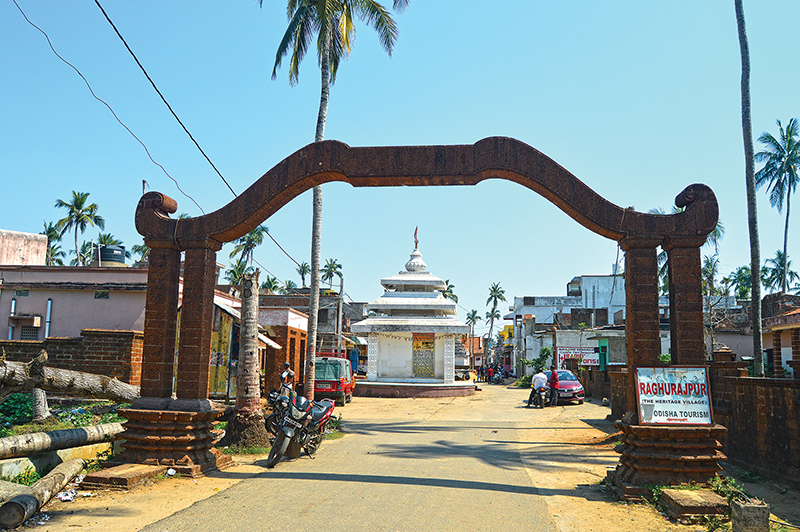
The bow-shaped gate signifies entry to Raghurajpur
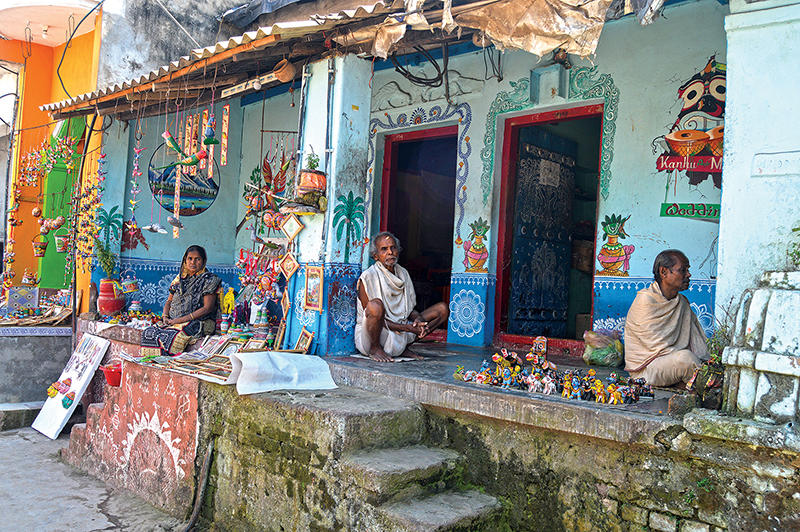
A typical house displaying handicrafts on sale
Sachikanta Sau, another artisan, related an interesting anecdote. After the festival of Rath Yatra, Lord Jagannatha supposedly suffers from fever, owing to endless bathing during the festival. During this period, when the Jagannath Temple remains closed, the priests come down to the Raghurajpur village and hone their skills in patachitra.
Tutu, another artisan, told us that they practice their signature patachitra craft in their own houses and also display their handcrafted items in one of the rooms. Interestingly, the village Raghurajpur is as old as the Jagannath Temple of Puri, and the villagers here live in harmony. Unlike Nayakpatana, villagers here do not try to grab customers for the business. Visitors move here freely interacting with the artists. We visited several houses and bought a few handicrafts as souvenirs.
We came back from Raghurajpur early enough to be able to watch the mesmerising sunset slowly sink into the mighty sea from the sprawling terrace-restaurant of our East West Hotel over the dinner.
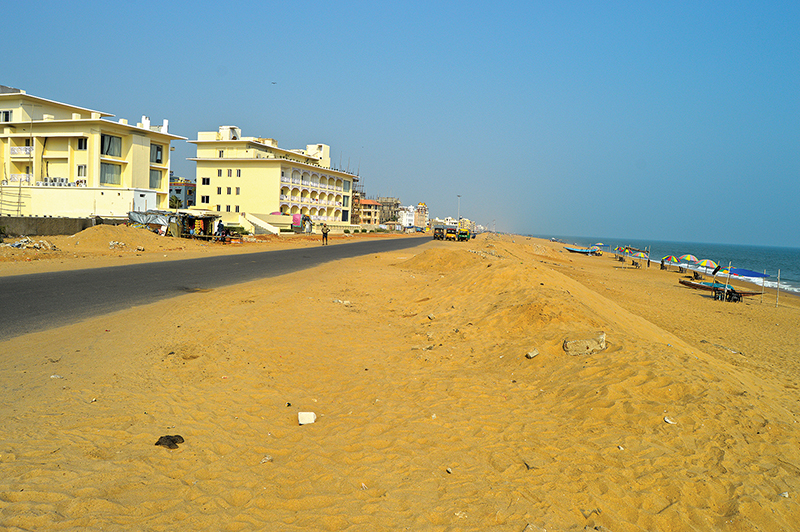
The exotic East-West Hotels on Puri Beach
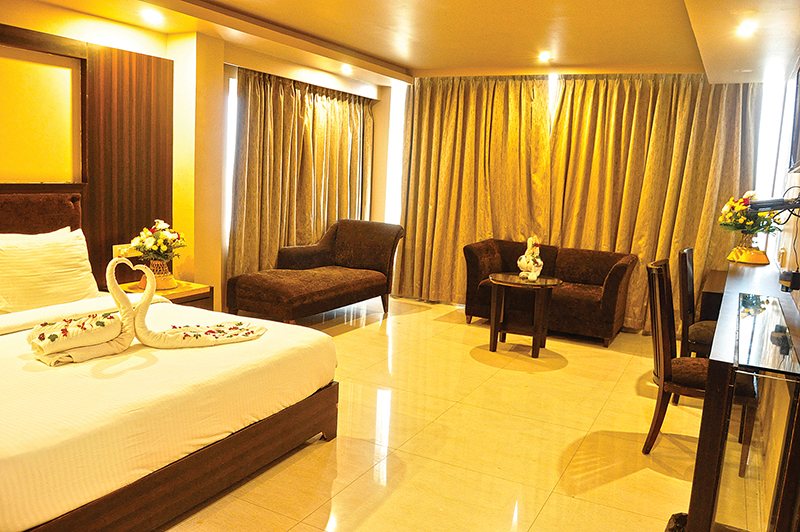
A deluxe suite at East West Hotels, Puri
The grandeur of the East West Hotels with its strategic location made our stay at Puri a memorable one. Lulled by the sun, the sands and the sea, packing up for home was not easy. The journey back home was smooth and we stayed silent, engrossed in our own thoughts. We all vouched, that although there is no dearth of splendid beaches in our country, Puri undeniably casts a magnetic spell over its visitors, luring them to come back to it again and yet again.
Raghurajpur Artisans:
Abhimanyu Bariki (Patachitra artist)
Cell: 7873413607
Sachikanta Sau (Palm leaf engraving artist)
Cell: 7873413607
Jeetu Sau (Patachitra artist)
Cell: 8596978085
Cittaranjan Swain – Cell: 9937313573
Jitendra Nayak (Gotipua and Odissi Dancer)
Cell: 8342811499
Gopal Maharana (Patachitra artist)
Cell: 9938693055
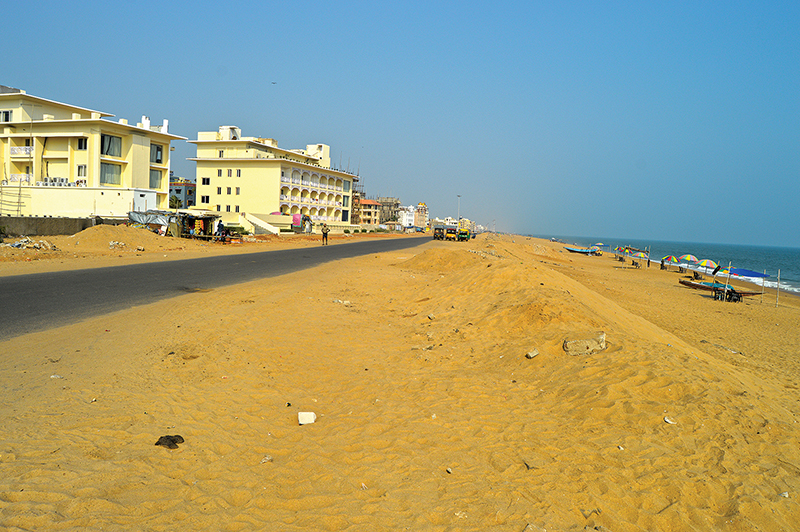
Standard : A